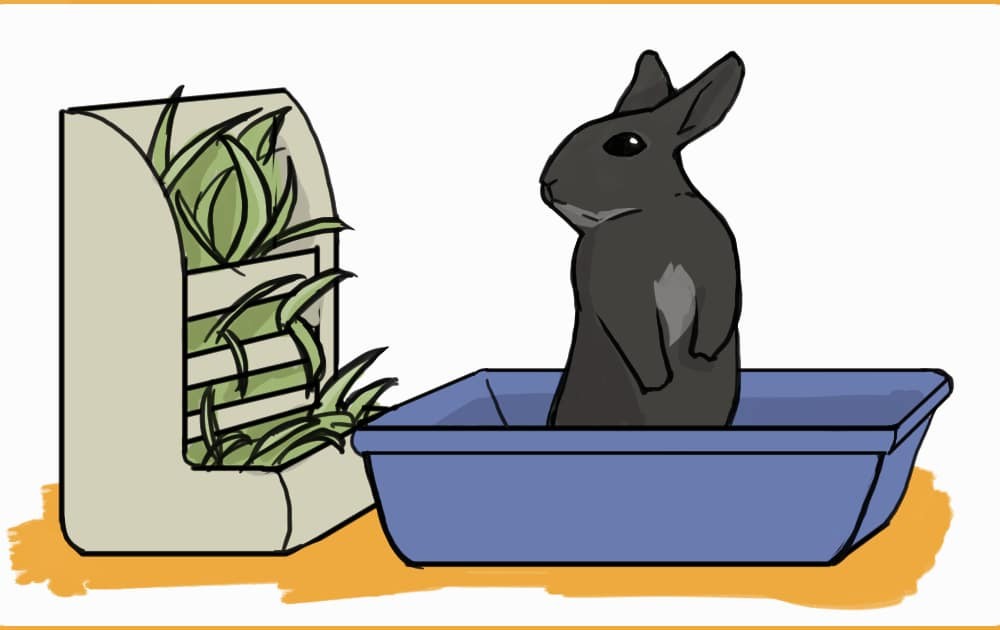Bringing a pet into your apartment can enrich your living space with companionship and joy. Among the many animals to consider, rabbits stand out as uniquely charming and relatively low-maintenance pets. However, the question remains: Are Rabbits Good Pets For Apartments? While often perceived as delicate and quiet, rabbits have specific needs that apartment living must accommodate. This comprehensive guide will explore whether a bunny is the right fit for your apartment lifestyle, covering essential aspects from space requirements to bunny-proofing, ensuring both your happiness and your furry friend’s well-being in a shared living environment.
Understanding if a Rabbit is Right for Your Apartment Lifestyle
Before hopping into rabbit ownership, it’s crucial to understand their nature and needs, especially within the confines of an apartment. Rabbits, despite their size, are not low-energy pets. They are intelligent, social creatures that require ample space to move, play, and express their natural behaviors. Confined spaces can lead to boredom and destructive habits, which is a significant concern in apartment settings.
Space Requirements for Apartment Rabbits
While you might think of rabbits as small cage-dwellers, they actually need much more room to thrive. A cage should only serve as a home base, not their entire world. Rabbits need daily exercise outside of their enclosure to prevent boredom and maintain their physical and mental health. In an apartment, this means dedicating a significant area for a spacious enclosure and ensuring a safe, bunny-proofed space for daily playtime.
Addressing the Chewing and Digging Instincts in Apartments
One of the biggest hurdles for apartment dwellers considering rabbits is their natural instinct to chew and dig. Rabbits explore the world with their teeth and paws, which can translate to damaged carpets, furniture legs, and baseboards if precautions aren’t taken. Understanding this natural behavior is the first step in mitigating potential damage and creating a rabbit-friendly apartment.
Noise and Odor Considerations in Shared Living Spaces
Apartments often come with shared walls, meaning noise and odor can easily travel to neighbors. While rabbits are generally quiet pets, they can thump their hind feet loudly when startled or excited, especially at dawn and dusk. Additionally, while rabbits themselves are clean animals, their enclosures can develop odors if not properly maintained. Managing both noise and odor is vital for harmonious apartment living with a rabbit.
Key Steps to Prepare Your Apartment for a Rabbit
Making your apartment rabbit-friendly is essential for a successful pet-owner relationship. Here are actionable steps to transform your apartment into a safe and comfortable haven for your bunny companion.
1. Verify Apartment Pet Policies Regarding Rabbits
Before anything else, confirm with your apartment management if rabbits are allowed. Don’t assume a “pet-friendly” label includes all types of animals. Lease agreements often specify cats and dogs, leaving other pets in a gray area. Direct communication with your landlord or apartment manager is crucial to avoid future complications and potential heartbreak of having to rehome your pet. Understanding the specific pet policy regarding rabbits will save you from lease violations and ensure a smooth tenancy.
2. Spay or Neuter Your Rabbit for Better Apartment Living
Spaying or neutering your rabbit is not just about population control; it significantly impacts their behavior, making them better apartment companions. Fixed rabbits are less territorial and, therefore, less likely to spray urine to mark their space. Urine spraying is not only unpleasant but can also damage carpets and wood floors in your apartment.
Furthermore, spaying or neutering often leads to a calmer temperament. Hormone-driven behaviors like aggression and moodiness are reduced, making them more agreeable roommates. While fixed rabbits may still exhibit chewing or digging when bored, it’s generally less intense and easier to manage than in unaltered rabbits.
3. Create a Dedicated Home Base Enclosure
Providing a home base enclosure is vital for your rabbit’s sense of security and for managing them within your apartment. This enclosure serves as their safe retreat, housing their litter box, food, and water. It’s also a space where they can engage in natural behaviors like stretching, hopping a few times, and exploring safe toys.
Enclosure Size Matters: Ensure the enclosure is appropriately sized for your rabbit. A general guideline is that it should be at least 3-4 times the length of your rabbit and 1-2 times their width, allowing them to stand fully upright on their hind legs without touching the top.
Even if you plan for your rabbit to have free roam of your apartment, a home base is still necessary. It provides a secure space for them when you’re not home, during cleaning times, or when maintenance staff needs access to your apartment.
Consider using a pet exercise pen (ex-pen) as an ideal enclosure. Ex-pens are spacious, customizable to fit different apartment layouts, easy to clean, and often more affordable than traditional rabbit cages.
4. Choose an Easy-to-Clean Enclosure for Apartment Convenience
Apartment living often means limited access to outdoor cleaning facilities. Hosing down a rabbit cage outside might not be an option. Cleaning inside a bathtub can lead to clogged drains from hay and litter. Therefore, an easily cleaned enclosure is a must-have for apartment rabbit owners.
Ex-pens with smooth, wipeable surfaces are excellent choices. Place an area rug or a waterproof mat underneath the enclosure to protect your apartment flooring further and simplify cleanup. For daily maintenance, sweeping and vacuuming around the ex-pen are usually sufficient. The portability of ex-pens also allows for easy repositioning during deeper apartment cleaning.
5. Maximize Space with Vertical and Multi-Functional Furniture
Apartment space is often at a premium. Integrating your rabbit’s needs without sacrificing your living space requires creativity. Vertical space utilization is key. Consider loft beds or shelving units that allow you to dedicate the space underneath for your rabbit’s enclosure.
Multi-functional furniture can also help. Using the space under a sturdy table or desk as part of the enclosure can seamlessly blend your rabbit’s area with your living space. Ex-pens can be configured to wrap around furniture legs, effectively creating a designated bunny zone without taking up additional floor space.
6. Protect Carpets and Flooring from Digging and Chewing
Rabbits’ natural digging and chewing instincts pose a significant threat to apartment carpets and baseboards. Proactive protection is essential to prevent damage and maintain your rental agreement.
Corner Blocking: Rabbits often target room corners for digging. Use furniture strategically to block off these corners, denying access to vulnerable carpet areas.
Area Rugs and Protective Mats: Cover carpeted areas, especially along walls and under furniture, with durable area rugs or plastic mats. Natural fiber rugs like seagrass or sisal are safer for rabbits if they chew, minimizing the risk of ingesting harmful synthetic materials. While determined rabbits might still dig at rugs, replacing a rug is far easier and cheaper than repairing or replacing apartment carpeting.
7. Regularly Trim Your Rabbit’s Nails
Regular nail trimming is crucial for your rabbit’s health and for protecting your apartment. Sharp rabbit nails can easily scratch wood floors and tear carpets. Overgrown nails can also snag, break, and cause injury to your rabbit, potentially leading to bleeding on your carpets.
Keeping your rabbit’s nails trimmed minimizes potential damage from scratching and digging. Even if your rabbit scratches at wood or rugs, shorter nails will lessen the impact. Regular nail care is a simple yet effective way to maintain both your rabbit’s well-being and your apartment’s condition.
8. Safeguard Baseboards from Chewing
Baseboards are prime targets for rabbit chewing due to their accessible height and often appealing texture. Chewing baseboards can cause significant damage and may expose rabbits to potentially harmful paints or materials used in apartment construction.
Prevention Strategies:
-
Physical Barriers: Initially, try blocking baseboards with furniture or using cat scratcher boards or flattened cardboard along walls to create a physical barrier.
-
Bitter Taste Deterrents: Apply a pet-safe bitter apple spray to baseboards. The unpleasant taste can deter chewing. Alternatively, a homemade solution of equal parts white vinegar and apple cider vinegar can also be sprayed on baseboards (test in an inconspicuous area first to ensure it doesn’t damage the paint).
-
Tape Barrier: Masking tape applied along baseboard edges can be surprisingly effective. The texture is often unappealing to rabbits. However, monitor your rabbit; if they attempt to ingest the tape, discontinue this method to avoid digestive issues.
9. Rabbit-Proof All Electrical Wires
Electrical wires pose a dual threat: danger to your rabbit from electrocution and potential damage to your appliances and apartment wiring. Rabbit-proofing wires is non-negotiable for apartment safety.
Comprehensive Wire Management:
- Elevate and Conceal: Whenever possible, run wires along walls, behind furniture, or use cord concealers to keep them completely out of reach.
- Protective Covers: For wires that cannot be fully concealed, use rigid plastic or spiral wrap wire protectors. These covers are durable and deter chewing, providing a crucial safety layer.
- Inspect Existing Wiring: Check for exposed wires, especially near baseboards or behind appliances, that may be part of the apartment’s infrastructure. Block access to these wires with furniture or barriers. If you find damaged or exposed apartment wiring, notify your landlord immediately for repair.
10. Litter Train Your Rabbit for Apartment Hygiene
Litter training is essential for maintaining cleanliness and hygiene in an apartment with a rabbit. Untrained rabbits can leave droppings and urine throughout the apartment, leading to odors and potential floor damage. Litter training confines their waste to a designated area, making cleanup manageable and keeping your apartment smelling fresh.
Beyond cleanliness, litter training aids in monitoring your rabbit’s health. Changes in their fecal pellets or urine output are easier to observe when they consistently use a litter box, allowing for early detection of potential health issues.
Litter Training Tips:
- Hay and Litter Box Placement: Rabbits naturally eliminate while eating hay. Place their hay feeder near or directly over their litter box to encourage box usage.
- Positive Reinforcement: Reward your rabbit with praise or a small treat when they use the litter box.
- Consistency and Patience: Litter training takes time and consistency. Clean accidents outside the box thoroughly to eliminate odors that might attract them back to the same spot.
11. Maintain a Calm and Quiet Apartment Environment
Rabbits are sensitive to stress and loud noises. Apartment living, with its shared walls and potential for neighborly sounds, requires extra consideration for your rabbit’s well-being. A calm and predictable environment helps rabbits feel secure and reduces stress-related behaviors.
Creating a Peaceful Home:
- Establish a Routine: Rabbits thrive on routine. Consistent feeding times, playtime, and quiet periods help them feel secure and in control of their environment.
- Minimize Loud Noises: Avoid loud parties or gatherings that can startle your rabbit. Be mindful of noise levels from TVs, music, and conversations, especially during peak rabbit activity times (dawn and dusk).
- Safe Retreat: Ensure their enclosure is in a quieter area of the apartment, away from high-traffic zones and loud appliances. This provides a sanctuary where they can relax and feel safe from external noises.
Conclusion: Rabbits Can Thrive in Apartments with the Right Preparation
Are rabbits good pets for apartments? The answer is a resounding yes, provided you are prepared to meet their needs and adapt your apartment accordingly. By understanding their natural behaviors, creating a safe and enriching environment, and committing to responsible rabbit care, you can enjoy the delightful companionship of a bunny in your apartment. With careful planning and dedication, apartment living can be a happy and harmonious experience for both you and your furry friend.
For more in-depth information and guidance on rabbit care, explore resources like the Bunny Lady website and consider subscribing to newsletters for ongoing tips and advice to ensure your apartment bunny thrives.

